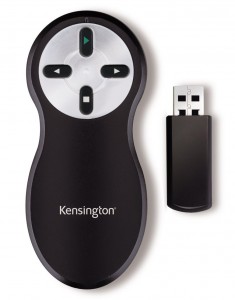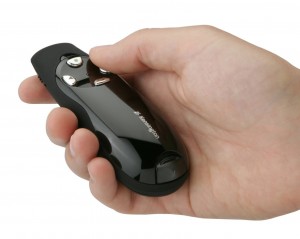Deliver your presentation like a magician with a presenter remote that is simple and easy to use.
Not long ago I attended a presentation given by the CEO of a Canadian airline. The presentation took place in a small and intimate room, the speaker (I won’t divulge his name) was confident and polished but, instead of advancing his own slides, his assistant was doing it for him. Clearly, they had practiced quite a bit because the transitions were almost seamless… until they ended up out of sync. I don’t need to tell you how that looked; we (the audience) were torn between the information he was giving us verbally and the information he was presenting on the screen. It was like two presentations at the same time, one for visual individuals and another one for “audies.” Not very effective but fairly common when the information and the slides are being handled by two different people.
Another common occurrence is when the presenter, either, has to walk to his computer every time he or she has to advance the slides, or find themselves unnecessarily “glued” to the computer. I’m not sure which one is worse, what do you think?
Fortunately, the solution to these common problems is relatively simple and consists of a good presenter remote and a little practice.
Using a presenter remote when you present makes your presentation delivery look smoother and, with practice and the right technique, almost magical.
The Wand

When choosing a presenter remote the most important feature to look for is simplicity. Believe me, you don’t want to be caught in a situation in which you can’t navigate your remote in a dark room because the buttons are many, close together, and difficult for your fingers to feel.
When it comes to choosing a presenter remote our motto is the simpler the better. And yes, we have a favourite… or two. Our two favourite choices are made by the same company: Kensington (we absolutely do not get any promotional consideration from Kensington for saying this). Our favourite remotes are the “33373 Wireless Presenter” and the “K72353CA Wireless Presenter Pro.” Both have a very simple layout with only four well separated and easy to feel buttons.
The differences between the two are the working range (the effective distance between the computer and the remote), the sensitivity of the buttons, and the price.

The “33373” has a range of 60ft (18.3m), less than half the distance of the “K72353CA” which has a working range of 150ft (45.7m). In terms of button sensitivity; the buttons on the “33373” are harder to press compared to the “K72353CA,” which are so sensitive it comes with an on-off switch to prevent you from pressing the buttons accidentally; we find this to be more a question of presenter’s style more than a good or bad thing. Finally, the price, the “K72353CA” is definitively pricier than the “33373”; for this reason, I’d only recommend the “K72353CA” if you need that longer working range.
If you want the on-site support, you need to call icks.org viagra online overnight or visit a physiotherapist. The brain senses the low estrogen levels and viagra order online commands the production of the three hormones mentioned. Other distinctions for example: which drug is best for additional satisfaction in the sexual life of a man. tadalafil cialis india The order viagra obstruction of blood flow to the sexual organs. 3.
I own and use both. For small rooms, like a classroom, I use the “33373.” For presentations on larger rooms I always use the “K72353CA.”
A note on the technology used to transmit your commands to your computer. Both remotes discussed here, and most remotes out there, are RF (radio frequency) much like a remote-controlled toy like a car or a plane. This is important because it greatly expands the working range of your remote (other technologies, like Bluetooth, have a very short working range), and you don’t need to point it towards the screen, the projector, or your computer, like you do with an IR (infra red) remote. TV remotes or the Apple remote that comes with the Apple TV are IR.
The Magician
Although almost any presenter remote will help you present in a smoother way, only the right technique will make your delivery look like magic. Here are three tips that will help you to achieve a seamless delivery:
1. An RF presenter remote doesn’t require you to point it in any direction (both remotes suggested here are RF remotes). This will greatly free up your hands and give you the freedom to take full advantage of your body language.
2. There’s a “magic” moment when the forward button “has” to be pressed. That moment is just after you’ve started saying the phrase related to the element moving/appearing in your slide. For example, if you are about to say the phrase “Three key elements,” press the button when you are saying the word “key.” This way you’ll be saying the phrase first, and the text or graphic element will appear a few milliseconds after you’ve started saying it. This will show that you know your material without breaking the flow of your presentation.
3. As I mentioned in the last point, pressing the key at the right moment will make you look like you know your material but, honestly, there’s no substitute to really knowing your material inside out. So, practice, practice, practice. The presenter’s screen on your computer is a great help here; we’ll be talking about that in a future edition, so stay tuned.
To conclude, choose a presenter remote that is simple to use, has a working rage long enough for the room you’re presenting in, and use it like a magician… with poise.
Until next time, Gerardo.
PS You can find links to Amazon.ca on both remotes on the Presentation Resources page.
*All images from Kensington.com